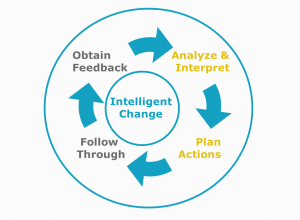When you walk in the room, who shows up for Read more →
Smart Goals
Posted Tuesday, August 21, 2012By Dr. Allen Slade, ACC
Leaders set goals for themselves and others. The most powerful goals tend to be specific, measurable, actionable, realistic and time-bound. Here are my thoughts on how to set smart goals:
Specific – the goal states a specific outcome or action. If your goals are stated only as outcomes, there may be no obvious steps to take. You don’t want to be like the basketball coach who talks about winning but has no plan for today’s practice. If all of your goals are actions, you can get disconnected from your ultimate purpose, like the basketball coach who focuses only on holding a great practice. I encourage my clients to set a mix of outcome goals and action goals, covering both the end to be achieved and the means to that end.
Measurable – the goal can be assessed against an objective standard. We tend to value what we measure and measure what we value. Without measures, your goal is light-weight. The measures can be hard, in the form of objective numbers. Numeric metrics are straightforward, but easy to measure does not equal important. Your measures may need to be soft, in the form of assessments of key stakeholders. And some measures are binary: Did the desired activity or outcome happen (yes or no)? Different goals require different metrics, but all goals should be measurable.
Actionable – the goal can be acted on by the person who holds the goal. Your goals are powerful only if you can personally take steps to accomplish the goal. As a leader, set goals with your team that are in their realm of possiblity. Otherwise, you will undermine their motivation and your credibility.
Realistic – the goal is difficult but attainable. Harder goals increase performance. But goal difficulty has limits. When a goal becomes unrealistic, its power disappears. When setting goals for ourselves, you should think through your odds of success. When setting goals with others, have an open two-way discussion of the goal to get the level of difficulty right. Difficult goals are good, but they must be attainable.
Timebound – the goal has clear timing, either a date or a rate. For one-time goals, use a due date. “I will accomplish this action by April 1 of next year.” For ongoing goals, use a rate of action or outcome. “I will sell $100,000 of new consulting business per month.” Without a date or rate, a goal is not specific or difficult.
With all five smart features, your goals will have maximum impact. And, all five feature should reinforce each other. The specific actions should be realistic, the metrics should have a date or rate, etc.
It is possible to go overboard – to be too smart for your own good. With my leadership coaching clients, less is usually more. At first, I encourage them to focus on just one or two behaviors to change. Taking on too many changes creates frustration rather than change. We often start with goals that are general. For example, a client increasing visibility might start with “Notice how much airtime I take up in meetings.” This is not specific, but sometimes that is all that is needed to trigger change. If a stronger trigger is needed, we move to a more specific goal, such as “I will speak up twice in every meeting.” If that doesn’t works, we can move to an even smarter goal, such as “In Monday’s meeting, I will comment twice on product quality. In advance, I will analyze some data and prepare a customer story.”
Almost every goal could benefit from being a bit smarter. Yet consider what works for you. Some people thrive on smart goals tightly linked to their life purpose and their daily schedule. Others need nothing more than a Post-it reminder. And, once your goal is in play, notice how it works for you. If you are making progress and accomplishing what you want, that goal is right for you. If your goal is not working, consider making your goal smarter.
 When leading others, it is essential to personalize goals. For example, at the beginning of the performance review cycle, use lots of participation in setting goals. Don’t just exchange drafts of the performance plan. Have a detailed discussion of what works. Check to make sure your team members believe their goals are actionable and realistic, because it is their acceptance of the goal that will drive performance.
When leading others, it is essential to personalize goals. For example, at the beginning of the performance review cycle, use lots of participation in setting goals. Don’t just exchange drafts of the performance plan. Have a detailed discussion of what works. Check to make sure your team members believe their goals are actionable and realistic, because it is their acceptance of the goal that will drive performance.
It is also important to agree on metrics and time for each goal at the beginning. Then, during the peformance review, you and your team member will be on the same page with feedback.
Bottom line: You should set specific, measurable, actionable, realistic and time-bound goals, for yourself and for others. When setting goals with others, have lots of dialogue. Be smart – create dialogue, insight and powerful goals to drive performance.


The distinction you make between action goals and outcome goals is highly valuable – and it’s so often missed in the goal-setting process. Too many people’s goals are either purely practical or purely aspirational.
Pingback: Too Many Goals?
Pingback: Got a Goal? Get A Metric!
Pingback: Good Goals Gone Bad
Pingback: Spoiling Good Goals with Bad Metrics
Pingback: Images of Goals and Metrics